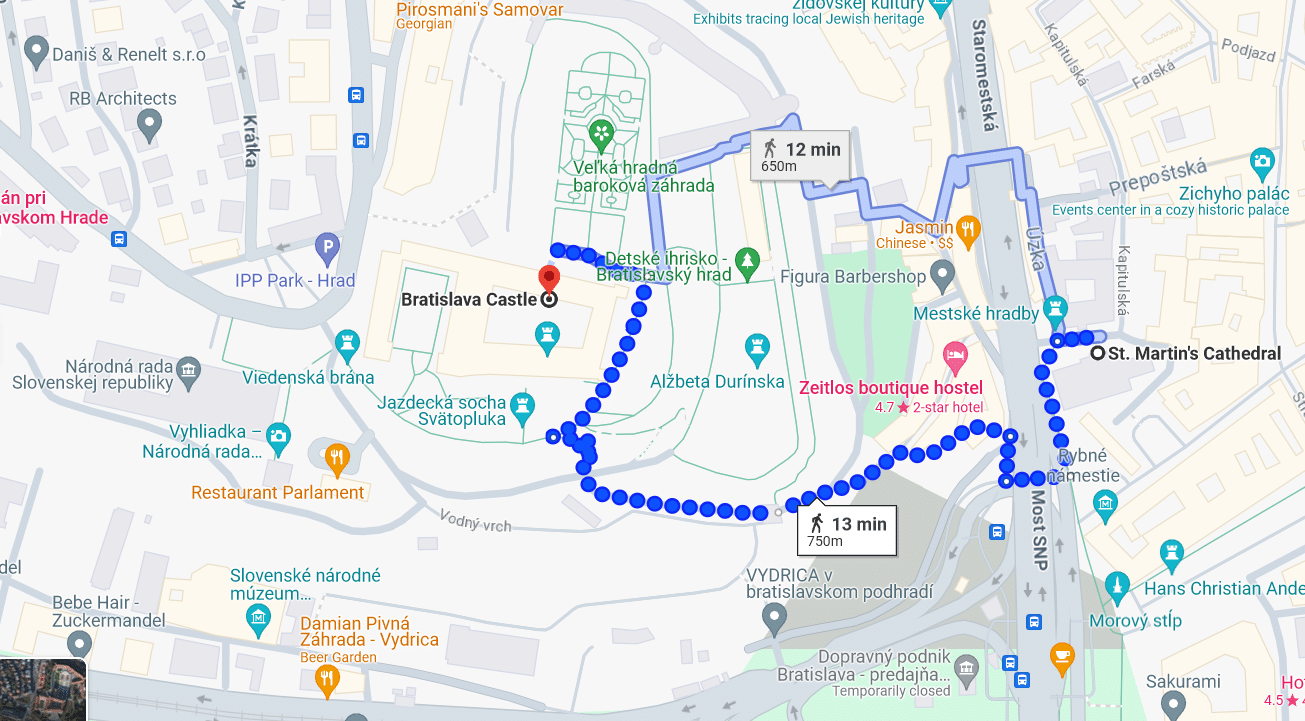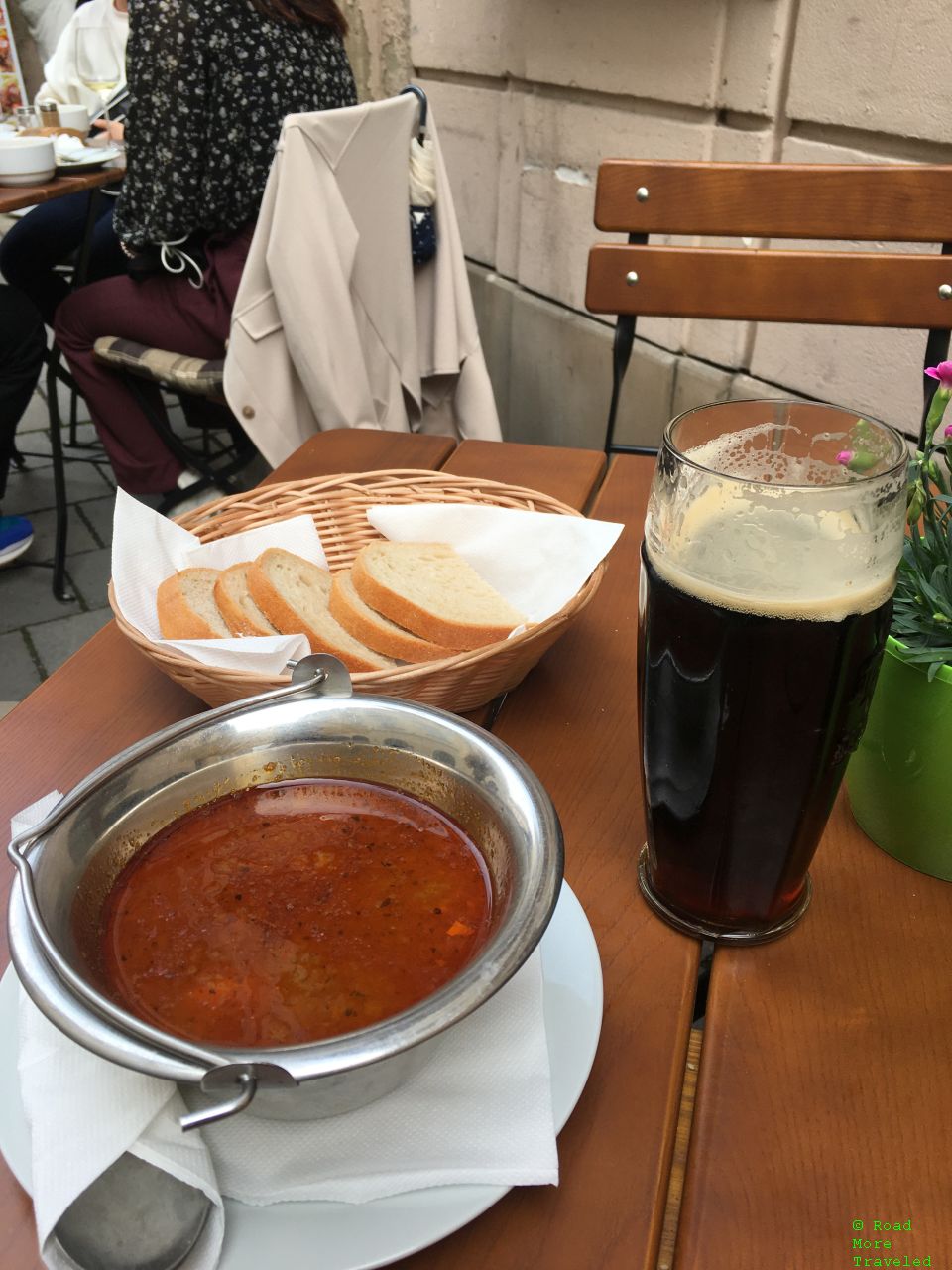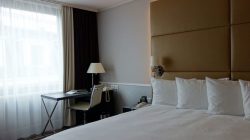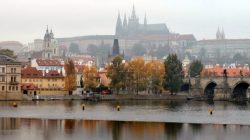After arriving on the Twin City Liner from Vienna, I set out to do as much as possible in a few hours. With my train ticket booked for 7 pm, that left enough time for a walking tour of Bratislava Castle and Old Town Bratislava. No, you won’t get an in-depth tour of either, but it’s better than nothing. Especially if you’re short on time.
Note: this post is part of my trip report series covering my visit to Austria in May, 2022. Click here for the trip report index and introductory post.
Walking Tour of Bratislava Castle and Old Town Bratislava – Getting To The Castle
Date of Visit: Saturday, May 7, 2022
Upon disembarking the ferry, you walk across the street to reach Old Town. The first thing you see is the Morový stĺp (Holy Trinity Column or Plague Column) monument. It’s a monument mostly seen in the former Habsburg empire. Like many others, it was built at the end of the last plague in 1712, in this case by an unknown artist.
I also took a quick snap of Old Town in anticipation of returning after touring the castle.
From here, there’s clear signage to get you on foot to Bratislava Castle. To reach the path, first walk north on the pedestrian path along the main road. Along the way, you pass St. Martin’s Cathedral and adjacent Rudnay Square. The Gothic cathedral is the oldest church in Bratislava, consecrated in 1452. The current exterior appearance, however, dates to a major renovation circa 1870. The church’s spire provides an unmistakable landmark throughout Old Town, measuring 85 meters tall. You can also see how the church was built into the city’s medieval walls.
Also nearby the cathedral is the Neolog Synagogue Memorial. The synagogue stood on this spot for centuries, even surviving both World War I and II. However, it ultimately couldn’t survive the designs of the Cold War Communist government. They tore it down in 1970 to construct the access road to the Nový Most Bridge across the Danube.
From near the Synagogue Memorial, there’s a path that goes underneath the road towards the castle. This shows my approximate route from there to the castle gates.
After crossing under, walk right along the road, and you’ll get a nice view of the medieval city walls.
Much like the hike up to Prague Castle, it’s a largely uphill hike through narrow cobblestone streets. (There are, in fact, multiple paths to the castle; some involve climbing stairs. When in doubt, looking for the signs that read “Hrad/Castle”.) It’s not quite as much of an elevation gain as the hike in Prague, though, with a shorter distance as well. As you climb the hill, the neighborhood resembles Lesser Town surrounding Prague Castle, though less colorful.
Further up the path, turn around for a terrific view of St. Martin’s Cathedral, Old Town, and the modern city beyond.
As you walk around the south side of the castle, you’ll come across a distinctly non-medieval structure ahead. That’s the National Council of the Slovak Republic (parliament building). It’s a pretty stark example of late Soviet architecture, completed in 1986 to house local government offices. Whatever you think of Soviet architecture, it certainly is…uniquely Soviet. Because Czechoslovakia was one country at the time, with the seat of government in Prague, the building isn’t nearly big enough to handle Slovakia’s parliament today.
From here, the path continues uphill for a ways, with the castle walls to your right.
And before long, you reach Vienna Gate and the imposing towers of Bratislava Castle.
Bratislava Castle Basics
Although the beginnings of Bratislava Castle date back centuries, what you see today dates mostly to…1968. So why the discrepancy? Read on to find out.
Like its famous cousin Prague Castle, Bratislava Castle dates to the 9th century. Due to its geography, the castle (originally known as Pressburg Castle) on the hill became an important garrison of the Great Moravian Empire. (Bratislava went by the name “Pressburg” until 1919.) And its geography left it largely impervious to invaders. As the Tartars devastated present-day Slovakia in 1241-42, the castle managed to hold. Later, during the days of the Ottoman empire, the castle’s key location helped thwart attacks on both Bratislava and Vienna.
Unlike Prague Castle, this one didn’t take quite as long to complete. The structure was largely completed by the 13th century, though several reconstructions occurred thereafter. These concluded with during Maria Theresa’s reign in the mid-18th century. However, the castle was abandoned following the death of King Joseph II, but remained a military garrison until 1811. At that time, tragedy struck the castle and the city, as a fire burned the castle to the ground on May 30th. The castle then remained in ruins until an ambitious project to rebuild the castle after World War II. That project finally completed in 1968, with the current castle rebuilt mostly in the Baroque style following the castle’s 1647 renovation (which completed the four towers seen today).
You can walk around the exterior castle grounds for free. However, visiting the interior and the Slovak National Museum requires tickets, at a cost of 10 euro. A “Bratislava Card” tourist card includes entrance to the museum. One thing to keep in mind is that the castle is significantly smaller than Prague Castle. You really need 6-8 hours to get through everything there, and that’s with limited time at each site. Bratislava is much more compact, and with fewer individual attractions to see. There’s the Slovak National Museum – Museum of History, the palace grounds, and the garden. If you just want a little taste of everything, you can walk through in an hour or two.
Tour of the Castle
Anyway, after passing through the gate, you’ll see the ticket office and entrance to the castle on the left.
Before going inside, I spent a few minutes admiring the view of the city, the Nový Most Bridge, and the Danube.
Then, I headed over to the ticket office for a museum ticket, and headed into the castle. Unlike Prague Castle, there’s no guards monitoring the doors. You can see the ornate designs on the face of the huge wooden doors.
This brings you into the main palace courtyard. I actually found myself a little surprised at how compact the courtyard is, relatively speaking. After viewing the massive courtyards of Prague Castle, or even the Alcázar in Sevilla, this one feels downright tiny. On the other hand, I found it considerably less crowded, even on a 70-degree Saturday afternoon in May.
I spent most of my tour looking through the Museum of History. Upon entering was a small exhibit of some Roman-era artifacts.
Of course, entering the museum also gives you a glimpse of the palace’s ornate interior. To head to the next level of the museum, you first head down a very regal hallway. Then you climb the grand staircase up to the next floor. This is how the castle appeared during the reign of Queen Maria Theresa in the 1760s. During this renovation, the queen converted the military garrison into a royal residence in rococo style.
Why is the staircase both unusually wide and less steep than normal? The queen wanted to be able to ride her horse up the staircase. First world problems in the 1760s, I guess.
As you climb, you can look across and see the incredible symmetry of the palace interior. You almost see Moorish influences here with the arched entryways.
On my visit, several of the exhibits on the upper floors were unfortunately removed. Several rooms were closed off, others empty, and some seemed half completed. I’m not sure if this was planned maintenance, or just a slow ramp-up after the pandemic. In any event, there were still a few notable exhibits to see. Although Bratislava Castle has nothing like Prague’s St. Vitus Cathedral, there is an on-site chapel on the premises. Complete with a church organ, in fact.
Next door, there’s a ginormous grandfather clock.
Then, I headed over to a couple of mostly empty rooms with some 17th/18th century artwork. The first two paintings are of a Slovak military battle, and the others of the royal family. The chandelier was also quite notable.
The most interesting exhibit, to me, was one covering the Velvet Revolution of 1989. This exhibit featured a variety of protest posters and slogans from the anti-Communist uprising that began on November 16, 1989. As with the larger demonstrations in Prague, the protests proceeded peacefully, until the overthrow of the Communist government in December.
Next door, there was an interesting collection of still-life paintings from Slovak artists depicting agricultural life in Slovakia in centuries past.
Also in this section was a mock-up of a typical rural Slovak house in the early 20th century.
Also from the higher floors, there are some great views of the Baroque Garden on the north side of the castle, and the city beyond. You can see the entire Northern Bastion of the castle, along with the satellite building extending from the Nicholas Gate.
From there, I made my way out of the castle, and back out of the courtyard the way I came. Through the doorway, there’s a statue of Svatopluk, ruler of the Great Moravian Empire in the late 9th century. It’s likely, though not certain, that construction on Bratislava Castle began during Svatopluk’s rule. Today, he watches over a bustling, modern European city.
Note that today, the museum also features a Treasury exhibit of gold and silver works made throughout the castle’s history. This wasn’t open on the day of my visit, however.
I then walked over to the gardens to take a quick look around. Before reaching the gardens, you reach the ruins of the Great Moravian Basilica. Although no cathedral currently resides on the grounds of Bratislava Castle, this wasn’t always the case. When the castle was built, one of the largest Great Moravian basilicas stood in this spot, on the east side of the castle. Later, in the 10th century, the Romanesque cathedral of Saint Savior replaced the Great Moravian basilica. However, in 1221, the priory of Bratislava moved to St. Martin’s Cathedral, and the cathedral here closed permanently. Today, all that remains are a few foundation stones and plaster remains on the castle grounds.
From here, it’s a short walk to the Baroque Gardens. As the name suggests, the gardens comprise a more recent addition to the castle grounds. Queen Maria Theresa added these beginning in the 1760s, with completion occurring by 1784. The maze-like gardens almost feel like a miniature version of the Jardines de Sabitini at the Palacio Real in Madrid. This spot also provides a nice vantage spot of the northern bastion and outer castle wall.
Looking back, you can see the wide, gently-sloped staircase back up to the castle. Again, supposedly so that Queen Maria Theresa could ride her horse directly up to the castle.
To the right are is the Winter Riding School building, an equestrian center also founded by Maria Theresa.
And then, one last look at the satellite building at the north end of the palace complex.
Walking Tour of Bratislava Castle and Old Town Bratislava – Old Town
And with that, I headed back to Old Town. To get back to the city, simply follow the signs to “Historic Centrum” or “St. Martin’s Cathedral”. I ended up tracing my same path back, returning back to Morový stĺp to begin my walk of Old Town. From here, I just started wandering down one of the main streets (Panská). The short-term aim? Find some goulash to cure my hunger after walking to the castle and back.
After visiting several “old town” areas in European cities, I’ve found all of them have roughly the same setup. The same narrow, cobblestone streets, centuries-old cathedrals, and cheesy souvenir tourist traps exist everywhere. And yet, I keep going back for more every time I end up in Europe. There’s just enough different about every city to make the walk worthwhile. Anyway, the aforementioned narrow cobblestone streets, pretty old buildings, and souvenir shops greet you from the start.
Fairly quickly, this street led to an area lined with cafes to the right.
After perusing the menu on the door, I decided to give a placed called Reštaurácia Pivnice u Kozla a try. The beautiful spring weather just begged for an outside table. And so I enjoyed some goulash and a beer while people watching for a little bit. The goulash I had in Prague was better, but this was still pretty good. And it hit the spot after the long walk to and from the castle.
After getting my belly filled, I headed down the street and quickly found the Slovak National Theater. The striking Neo-Renaissance opened in 1886, and still hosts opera, ballet, and drama productions. Meanwhile, the interior of the theater is known for its collection of paintings, many by Slovak artists.
In the adjacent Hviezdoslav Square, some kind of Falun Gong demonstration was going on.
I checked out a little more of the area from there. First, I ended up on a side street near an art gallery. After turning around, I headed east again towards the edge of Old Town, and found an odd looking castle sign. There’s no castle here, though, just a jewelry shop in the building it’s attached to.
Once you reach the streetcar tracks, you reach the east end of Old Town. This is a much quieter, less touristy portion of the historic district.
At this point, I turned around on a street heading back to Hviezdoslav Square. As you reach Gorkeho Number 4, you’ll see a unique looking building in front of you. This is the Chamber of Commerce and Industry Building, originally constructed in 1903 by Slovak architect Josef Hubert. The building housed the headquarters of the Slovak National Theater until 2004, and underwent a full renovation completed in 2019. The Gothic-style corner towers certainly stand out amongst all the other buildings in the area.
Then, I walked back in the general direction of the square. As you pass the square, on the south side is the landmark Radisson Blu Carlton Hotel. This hotel has an on again-off again history common for opulent historic hotels in cities that faced hard times. A hotel has sat on this site since the 13th century, originally named The Swan. The hotel expanded over time, taking over the footprints of adjoining hotels The Three Green Trees and The National. Eventually, in 1912, a new combined hotel complex named The Carlton-Savoy was completed, though the hotel you see today was the result of yet another expansion in the late 1920s.
Until the German army took over the hotel during World War II, The Carlton-Savoy earned a reputation as one of the finest in Europe. It hosted many famous figures, including Thomas Edison, Theodore Roosevelt, and Alfred Nobel. The hotel gradually fell into disrepair after World War II, eventually closing in 1992. In fact, it barely avoided demolition in 1977, saved only by the protests of preservationists. A renovation plan finally materialized in 1998, and the hotel reopened as The Carlton in 2001. Today, the hotel is managed by Radisson Blu, and again rates as one of the best in Europe.
After admiring the hotel, I headed down to the Pavol Országh Hviezdoslav statue and fountain. The namesake of the adjacent square, Hviezdoslav was Slovakia’s most famous poet, and was considered a revolutionary in the area of literary realism.
To wrap up my time in Old Town, I headed in the direction of Main Square (Hlavné námestie). But first, I couldn’t resist a view of Bratislava Castle down a side street. Fittingly, in front of the Central European House of Photography.
Main Square is one of the best known squares in Bratislava. At the center of Main Square is Maximilian Fountain, sometimes known as Roland Fountain. As the name implies, Maximilian II, king of Hungary, commissioned its construction in 1572 to provide a public water supply for the city.
Behind the fountain to the north (the yellow building) is the Vice Governor’s Palace (Miestodržiteľský palác). I can’t find much information about this palace, but it dates to at least the 18th century. At that time, the then city of Pressburg purchased the building for government use. The Slovak Republic still owns the building, using it for special events.
S
The other notable landmark on the square is the Church of the Most Holy Savior, also called the Jesuit Church. Well, it’s actually two separate landmarks. You might think the tower belongs to the church, but that’s not the case. When the Jesuit Church was built, the king decreed that it could not resemble a Roman Catholic house of worship, so it was built without a spire. So what does the tower belong to? It actually belongs to Old Town Hall, which predates the 17th century church by nearly 400 years. Constructed in 1370, and finished in the Gothic style in the 15th century, it’s one of the oldest stone buildings in Bratislava.
Finally, on the way to catch the bus to the train station, I walked past the Church of the Elevation of the Holy Cross. This Gothic-style church is actually fairly “young”, constructed in 1860. The spire with Bratislava Castle in the background is quite photogenic, though.
There are actually many more palaces and historic sites to see in this area. But if you only have an hour or two, hopefully this gives you a pretty good starting point.
Getting Back to Vienna from Bratislava
Numerous trains and buses run between Bratislava and Vienna, generally every 30-60 minutes. I took the train back, at a cost of about $20. Trains to Vienna run from both Bratislava-Petržalka and Bratislava Hlavna stations. You can reach Hlavna by tram or on foot (about 1 mile from Old Town). Petržalka, though, is much easier by bus (otherwise, it’s about 3 miles across the Novy Most Bridge on a busy thoroughfare). For reasons I still don’t remember, I decided to catch the OBB train from Petržalka. You can take buses 80 or 93 from Zochova bus stop, at a cost of (I think) €1.80. I believe there is also an express bus from Old Town, at a slightly higher cost.
One thing to keep in mind – some OBB trains show Deutschkreutz as the final destination. These trains do transit through Vienna, though. Look for “Wien Hbf” on the list of stops to confirm you are on the right train.
Final Thoughts
If you’re looking for an ideal day trip from Vienna, Bratislava makes a very good option. It’s just an hour away, you get to cross another country off your list, and there’s plenty of sites to stitch together a self-guided walking tour. Even if you only have a few hours to spare.






































































